Applied Energy ( IF 11.2 ) Pub Date : 2020-09-14 , DOI: 10.1016/j.apenergy.2020.115842 Gianluca Greco , Christian Di Stasi , Filipe Rego , Belén González , Joan J. Manyà

|
In the present work, the effects of the peak temperature (400–550 °C), absolute pressure (0.2–0.9 MPa), gas residence time (100–200 s) and reactor atmosphere (pure N2 or a mixture of CO2/N2) on the pyrolysis behavior of wheat straw pellets were investigated. A factorial design of experiments was adopted to assess the effects of the above-mentioned factors on the pyrolysis products, the exergy efficiencies related to them and to the overall process, and the heat required. The pyrolysis energy/exergy assessment is nowadays of great interest, for the scaling of the installations from lab-scale to commercial-scale. Results showed that, as expected, the peak temperature was the most influential factor on the yields and distributions of all the pyrolysis products as well as the char properties related to its potential stability and pore size distribution. However, an increased pressure enhanced the release of the gas species at the expense of the liquid products, without altering the final char yield. The char exergy efficiency was negatively affected by an increase in peak temperature, whereas its effect on the exergy efficiency of the produced gas resulted to be positive. It was also found that pressurized pyrolysis favored the exergy efficiency of the process, even at relatively high pyrolysis peak temperature. For the biomass feedstock and the range of operating conditions studied here, thermodynamic irreversibilities of the pyrolysis system were considerably lowered when the process was conducted at 550 °C, 0.9 MPa and using a mixture of CO2 and N2 as carrier gas at relatively short residence times.
中文翻译:

慢速热解条件对产品产量和特性及火用效率的影响:麦草的综合评估
在目前的工作中,峰值温度(400–550°C),绝对压力(0.2–0.9 MPa),气体停留时间(100–200 s)和反应器气氛(纯N 2或CO 2的混合物)的影响/ N 2)对小麦秸秆颗粒的热解行为进行了研究。通过了一项析因设计实验,评估了上述因素对热解产物的影响,与它们有关的热效率以及与整个过程有关的效率,以及所需的热量。对于从实验室规模到商业规模的装置规模的扩展,热解能量/火用评估如今已引起人们的极大兴趣。结果表明,正如预期的那样,峰值温度是影响所有热解产物的产率和分布以及与其潜在稳定性和孔径分布有关的炭性质的最重要因素。然而,增加的压力增加了气体种类的释放,但以液体产物为代价,而没有改变最终的焦炭收率。炭的火用效率受到峰值温度升高的负面影响,而其对产气的火用效率的影响却是积极的。还发现,即使在相对较高的热解峰温度下,加压热解也有利于该方法的火用效率。对于此处研究的生物质原料和操作条件范围,当该过程在550°C,0.9 MPa和使用CO的混合物进行时,热解系统的热力学不可逆性大大降低2和N 2作为载气的停留时间相对较短。

























 京公网安备 11010802027423号
京公网安备 11010802027423号